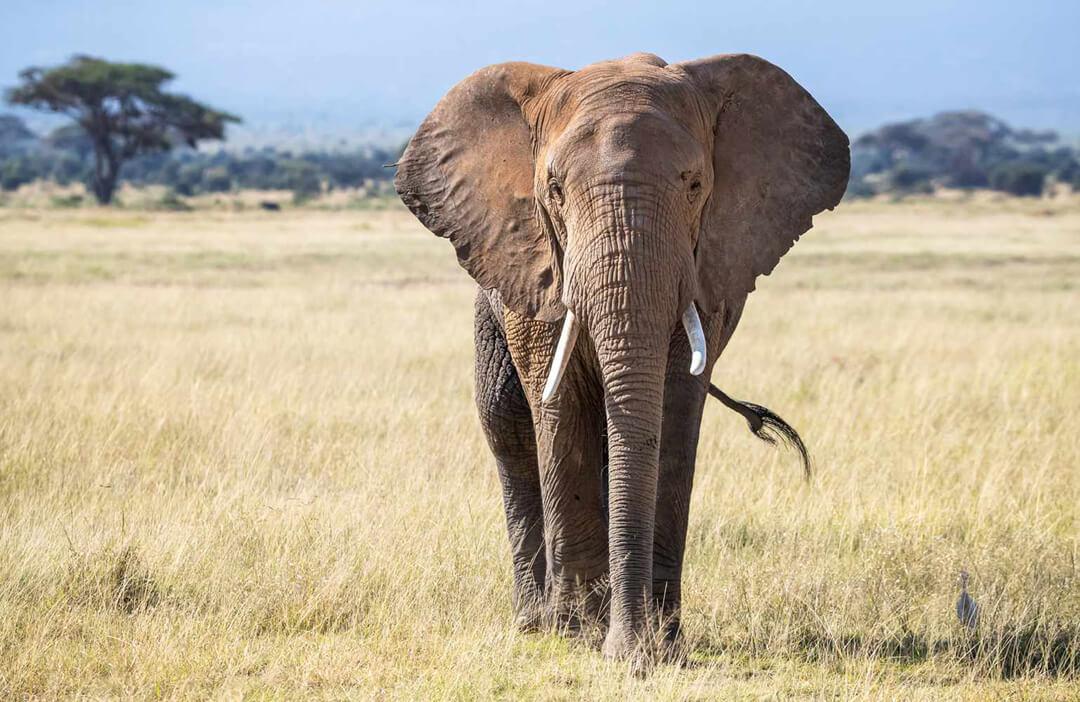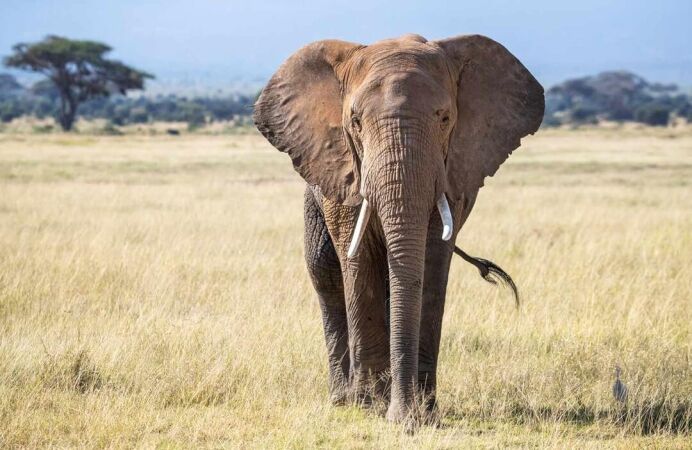

The world’s largest land mammal is mighty and majestic and will provide a world-class dangerous game hunting safari. An elephant bull with good weight, size, and beautiful ivory is considered by most big game hunting enthusiasts as Africa’s top hunting trophy.
Shots are mostly taken at close range due to thick vegetation at 20-50 yards. Use large caliber rifles that are capable of penetrating thick, strong, and dense bone. A .375 is the minimal legal requirement when it comes to dangerous game hunting in Africa. Rule number one when hunting an elephant is to choose the largest caliber rifle that you can shoot well and accurately. When elephant hunting in Africa, there is no room for error. A poor shot can turn into multiple fatalities. Forty and fifty caliber rifles loaded with 400 – 500 grain solids will be an excellent choice. The traditional game hunting safari technique is by tracking on foot. The real work will commence when a large fresh track has been found and the decision made that the tracks could lead to a trophy bull elephant. When we talk about shot placement on an elephant, the hunter needs to keep in mind what could happen next and needs to be prepared mentally and physically for a fast follow-up.
Penetrating a large herd and identifying a mature trophy bull is what elephant hunting in Africa is all about. Harvesting the trophy bull can be the finest sport in the arena of big game hunting.
As a first shot, neither a neck nor spine shot is recommended. The risk of a non-fatal shot is much too high, and the selected target area is just too small. Should the shot be taken, and the targets acquired, it would at least result in the elephant being immobilized. To confirm, this neck and spine shot is NOT a first option and must NOT be considered.
Big game hunting enthusiasts tend to watch way too many YouTube videos of charging elephants being shot in the brain from the front with big caliber double rifles and dropping dead at their feet. An elephant’s brain is about the size of a football and is heavily protected by thick and bulky bones. The problem with taking the frontal brain shot while elephant hunting in Africa, is that the brain lies far back in the skull which makes penetration from the frontal position a challenge.
As the elephant changes the position of its head, this changes the required angle of the needed kill shot. This point of aim will vastly change at varied distances from the hunter to the elephant. It is of utmost importance that before the hunting safari commences, the hunter studies the elephant’s brain position from every possible imaginable angle. The professional hunter will spend hours questioning the hunter on this subject. Your elephant hunting safari outfitter will normally have a few elephant skulls available for close examination before commencing the elephant hunt.
From the frontal position, the hunter cannot aim for either a heart or lung shot due to the positioning of both the trunk and the head.
At roughly 15 yards and depending on the size of the elephant, shot placement would be directly between the elephant’s eyes.
When an elephant is in a threatening position, the elephant will raise its head. This means that the hunter now must aim below the eyes to ensure the correct trajectory of the bullet to the brain.
As the elephant moves closer to the hunter, should he drop his head the shot will be higher.
If the hunter succeeds with the frontal brain shot, the first sign of success will be the back legs collapsing.
Should the hunter fail at the frontal brain shot attempt, well basically things will happen quickly, and all hell will break loose, to put it mildly!
The big game hunter will instantly have to recognize the mistake in shot placement and quickly reload and try to take a more accurate shot. It is doubtful that following the failed first shot the elephant will present another frontal brain shot. The elephant will usually at this point turn and run.
The sequence following a failed frontal shot will be:
1) An opportunity for a side brain shot
2) Followed by a shoulder shot
3) An elephant fleeing shot into the spine or the hip
We confirm that a frontal brain shot is NOT recommended as a first shot by the hunter when elephant hunting in Africa.
Shooting an elephant from the side is a much easier shot than the frontal brain shot. The position of the brain inside the skull is much easier to visualize.
A side-brain shot will drop an elephant in his tracks. When viewing the brain from the side, the position of the brain does not alter when the elephant moves his head and down. The only real factor affecting this shot would be the distance between the elephant and the hunter.
The perfect shot placement would be in front of the ear hole. A hand’s width or the equivalent of three to four inches. Using the ear hole as a central point, should the elephant be quartering slightly away or towards the hunter, the shot would have to be adjusted into the ear hole or just in front of the ear hole.
Like with the frontal brain shot on the elephant, the hunter will quickly know if the side brain shot was a quick kill or a miss.
For a big game hunter new to elephant hunting in Africa, the side-brain shot is not recommended as a first shot. The margin for error is large.
When a hunter is new to elephant hunting safaris, this heart/shoulder shot is highly recommended. The elephant’s heart weighs between 26-46 pounds. The length of an elephant’s heart is 22 inches with a width of 18 inches. These measurements make for a substantial target size. If the hunter understands the aiming point, shoots straight, and hits the target with the correct rifle setup, the result will be certain will be a successful elephant hunting safari. Shot placement on the shoulder is clear. The target for the heart, when the elephant is standing broadside, is about ¼ up from the start of the brisket to one-third to the pinnacle of the back behind the front shoulder. If the hunter pulls the shot slightly and hits the elephant slightly higher back, the net result will still be a perfect lung shot. The hunter must stay below the horizontal halfway point, else if too high the vital organs, such as the heart and lungs, may be missed. The hunter can be certain that the elephant is going to run so follow up the first shot as quickly as possible. We reiterate that this first shot is highly recommended. The target is big allowing for a greater margin of potential error. This is the preferred shot by most African professional hunters.
An African elephant after being shot and wounded, like most game animals, will turn away and flee from ever-present danger. The fleeing shot options are used regularly as the intent is to kill the elephant humanely and not to let him escape. The first option with the elephant running in the opposite direction will be the spine shot which is visible above the ridge of the tail. A direct hit into the vertebrae from this angle will immobilize the elephant. With the elephant running and the target smallish and mobile, this will be quite a difficult shot. This shot placement shot is named the “Texas Heart Shot” even though from this angle it is unlikely that vitals will be reached and penetrated. The second option is breaking the hips of the elephant. From the rear, the hip joint is visible at about the same level as the base / join of the tail to the body. Breaking a hip bone will most certainly slow down this mighty adversary. Many professional elephant hunters prefer shooting into the hip as the target is larger.
Due to the sheer size of the elephant, only marginal and slight angles are acceptable for body and brain shots. Your professional elephant hunter will assess the body position and will instruct the hunter whether to take the shot or hold back. The objective of the stalk will be to try and place the hunter into an acceptable shooting position.
While hunters always strive to ensure that the ultimate shot placement is achieved with the first bullet fired, when it comes to dangerous and plains game hunting safaris, we know this is not always the case. In many instances, the second shot is sometimes even more important as the result of a missed and poor first shot can be life-threatening.
Before your game hunting safari, practice shooting off sticks as well as unsupported / off the shoulder.
Practice using and working the action on a bolt action rifle.
Practice reloading your double rifle.
Make use of a small-caliber rifle like a .22, .223, or even an air rifle to practice with. Ammunition is affordable and the shot placement technique is the same.
Pay attention to where the professional hunter and his tracking team are at all times during the hunting safari.
Practice running in and executing the “Coup de Grace.”
When it comes to backup shots, do not rely on a professional to execute these shots. It is your game hunting safari and your African elephant hunt!
While hunters always strive to ensure that the ultimate shot placement is achieved with the first bullet fired, when it comes to dangerous and plains game hunting safaris, we know this is not always the case. In many instances, the second shot is sometimes even more important as the result of a missed and poor first shot can be life-threatening. Before your game hunting safari, practice shooting off sticks as well as unsupported / off the shoulder. Practice using and working the action on a bolt action rifle. Practice reloading your double rifle. Make use of a small-caliber rifle like a .22, .223, or even an air rifle to practice with. Ammunition is affordable and the shot placement technique is the same. Pay attention to where the professional hunter and his tracking team are at all times during the hunting safari. Practice running in and executing the “Coup de Grace.” When it comes to backup shots, do not rely on a professional to execute these shots. It is your game hunting safari and your African elephant hunt!